Sansevieria "Hanni": description of the variety and features of care
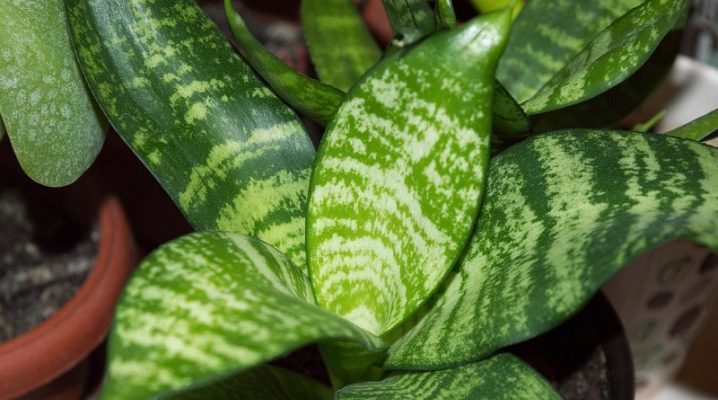
Many people strive to decorate their homes with flowers. You can create a wide variety of compositions from them, revitalize the interior, and the choices are simply endless. Often in apartments you can find such a plant as "Hanni" sansevieria. But before purchasing a plant, you need to know the description of the variety and take into account the features of care. Only in this case, the plant will delight for many years, and decorate the room.

Description and features
There are about sixty varieties of this plant. His homeland is the island of Madagascar. In our country sansevieria "Hanni" is popularly known as "pike tail" or "mother-in-law's tongue". In Great Britain it is called "tiger lily". The genus of these plants got its name from the name of the prince, botanist and philanthropist Sanseviero, therefore in Europe this plant began to be cultivated already in the 18th century.
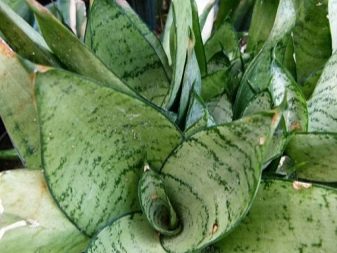
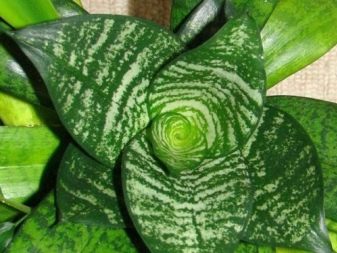
And in 1941, breeder S. Khan bred a new variety, which was named "Hanni Silver". The peculiarity of this variety is that the plant grows up to 30 centimeters, that is, it belongs to the undersized. Its leaves are large, dark green, growing upward, as if forming a vase. Twelve years later, another variety was bred - "Hanni Golden". Unlike the previous species, here the leaves are decorated with golden stripes. Also, the leaves have the ability to curl up. Of the varieties that have become widespread, you can name "Hanni Silver" and "Hanni Lucille Polan".
The description of the varieties indicates that this is a bright plant that grows successfully at home and can decorate any interior if it is correctly placed and well looked after. Flowering occurs in mid or late spring. Sansevieria shoots an arrow with small flowers on which there are drops of nectar. When the plant blooms, it spreads a subtle delicate aroma around itself.


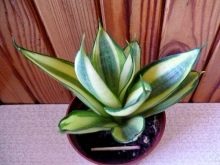
Planting and leaving
At home, sansevieria feels very good if you provide it with the necessary care, which is quite simple.
Almost all year round (except for winter), the optimum temperature for a plant ranges from 18 to 25 degrees. In the winter months, it should be at least +16, but this is the limit. At lower temperatures, the plant can become infected with diseases.
Watering should be moderate but regular. Do not allow overdrying or waterlogging of the soil. It is not difficult to check this: you need to take a little earth and grind it between your fingers - if the earth remains on your fingers, it means that it is sufficiently moistened. And if not, then the plant can already be watered. In winter, watering can be reduced. But it depends on what temperature is maintained in the room. If it is too hot or the plant is near a heater, the soil can dry out quickly. When watering, you need to be careful, the water should not fall into the center of the flower, because of this, the plant may begin to rot and eventually die.
If, when watering, there is excess water in the pan under the glass pot, it must be immediately poured out.

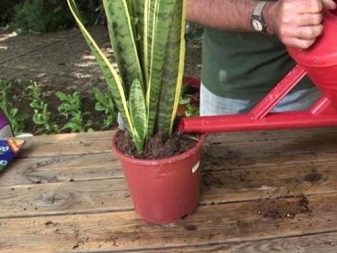
The sun's rays of sansevieria are needed, like other flowers, but it is desirable if they are diffused. Penumbra is also acceptable, all types of sansevieria tolerate it well. But for the owners of variegated leaves, the sun's rays are necessary, otherwise the leaves will not be bright.If the plant is located on the north side, where there is practically no sun, it should be provided with additional lighting using special lamps for several hours a day.
To plant "Hanni", you need to add humus, peat, sand to the ground. Drainage must be placed at the bottom of the pot. It can be fragments of bricks, small pebbles, sand. In terms of volume, the drainage should take up about a quarter of the pot. In spring and summer, the plant is fertilized monthly with mineral fertilizers. Florists note that fertilizers for succulents do very well with this task.
If the plant lives more in the shade, then it often does not need to be fertilized. Once every two months will be enough.
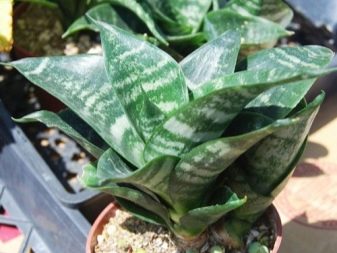
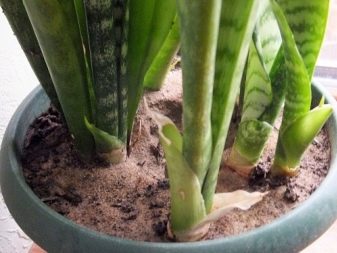
The choice of container for planting must be approached responsibly. This plant has very strong roots that develop as the ground part grows. The pot should be spacious in width, but not necessarily deep. The main thing is that it is durable. It is better to choose clay, since plastic can crack in case of root overgrowth. At the bottom, it is imperative to make drainage holes.
The plant does not require special care. If there are old yellowed leaves, they need to be cut off in time, as they spoil the appearance of the plant.
You can also remove dried leaf tips.
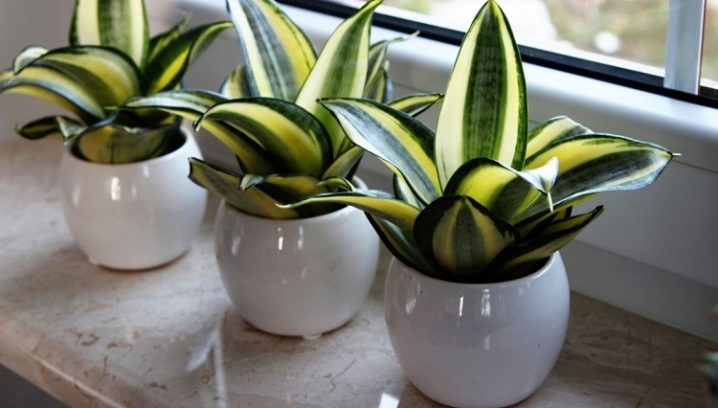
How to transplant and propagate?
As it grows, sansevieria should be transplanted. And the main signal for this may be that roots began to peep out of the drainage holes at the bottom of the pot.
Before transplanting into another pot, you need to put drainage on the bottom, then add some soil. After that, carefully remove the flower from the old pot, along with a lump of earth, so as not to damage the roots, and move it to a new pot. Then add the required amount of soil and water. But there is no need to abuse transplants, only as needed, no more than once a year.
The best and easiest way to reproduce at home is with the root. To do this, the plant is taken out of the pot, the root is washed well, a part is separated with a sharp knife along with the leaves, transplanted into another pot and watered well.
Reproduction is best done in early spring. Then the plant will take root better and get stronger for the winter.
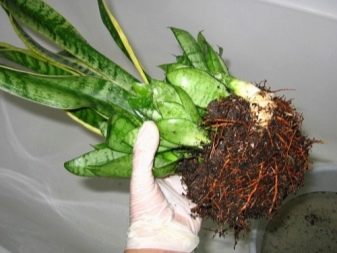
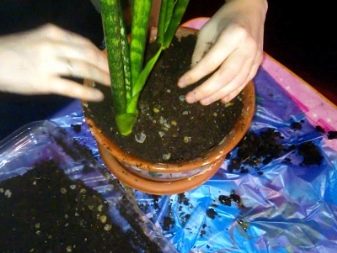
Another method is more complicated and time-consuming, but propagation by cuttings is also used. For this, a good healthy leaf is cut off. Then they cut it into pieces about 6-7 cm in size, these are the cuttings. They can then be grown in two ways.
- In the first case, they are placed with a lower cut in water, leaving the second part on the surface, and they are waiting for the appearance of roots. After they appear, the plant can be moved to the ground.
- In the second case, they are placed with a lower cut directly into the ground, and can be covered with a film on top for better rooting. With both methods, leaf cuttings can be treated with Kornevin for better germination.
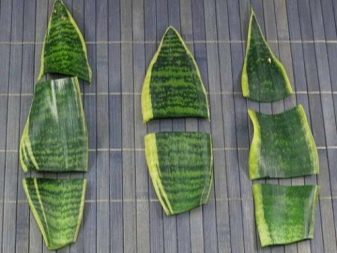
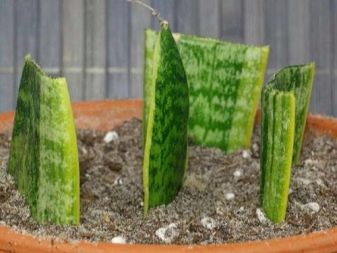
Some gardeners in the summer send sansevieria to flower beds, and this is the right decision. There she receives a sufficient amount of sunlight, air, and she is much more likely to bloom. Previously, the flower bed should be dug up, a hole should be dug no less than the height of the pot in which the plant lived, it is good to water the hole. Then carefully remove the flower from the pot along with a lump of earth and lower it into the hole. Then add earth, gently tamp, water the plant.
All summer you need to take care of the same as for other flowers: water, fertilize, loosen the soil. By autumn, when the temperature drops, you need to perform the opposite process: carefully dig up the plant and transplant it into a pot, but already larger in volume than it was before planting in the flowerbed.
The plant must be left on the terrace for several days, and then it can be brought indoors.
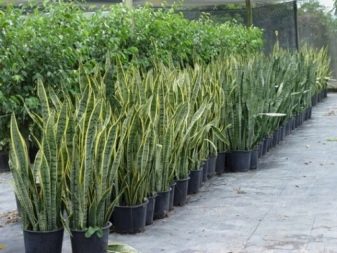
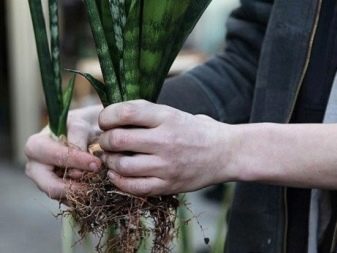
Pests and diseases
If the flower is properly cared for, it will not get sick and will feel great.
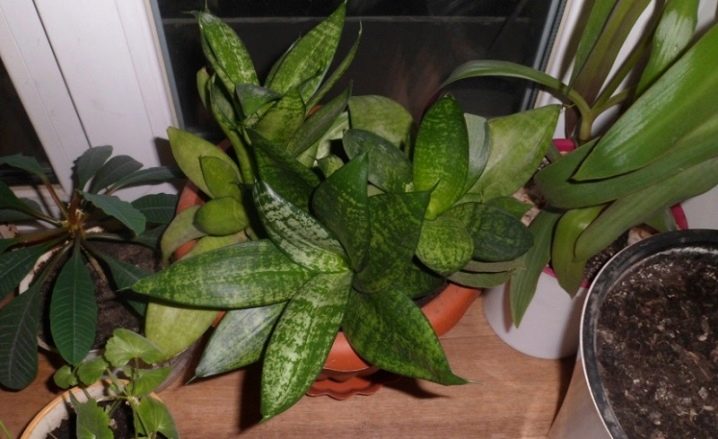
But if, nevertheless, something went wrong, the plant will tell you that it needs help.
- So, if the leaves turn yellow, it means that there is an excess of moisture. It is necessary to transplant sansevieria, remove damaged leaves, dry the roots.
- If the flower does not grow at all, it lacks warmth. The room temperature should be higher.
- The appearance of light spots on the leaves indicates that direct sunlight falls on them, which is why a burn occurred.
- And dark spots, on the contrary, signal excessive moisture and lack of light. If it's winter or rainy autumn outside, you can create additional lighting, at least 3-4 hours a day.
- Brown spots indicate a fungal disease. Then you need to cut off the affected leaves, treat the cut sites with fungicides, transplant the flower into fresh soil, and keep it in a warm room, reducing the amount of watering.
- Spider mites and thrips can invade the plant if it is weakened. They must be removed by treating the plant with soapy water. Transplanting to a new land will also be useful.
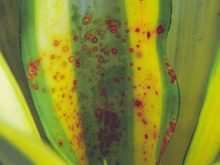

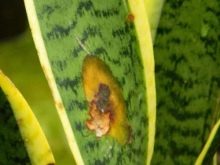
You can learn more about how to propagate Hanni Sansevieria by leaf.


























The comment was sent successfully.